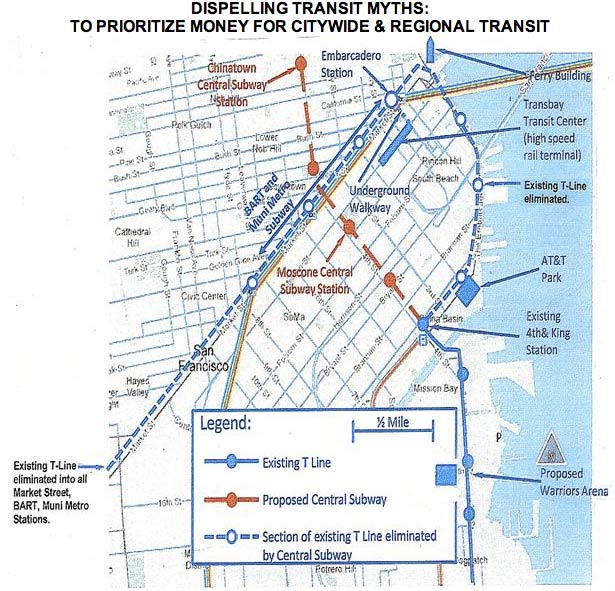Happy Chinese New Year!
Year of the Ram [Goat, Sheep]: Good Year for Good Resolutions
 “A gentleman would be ashamed should his deeds not match his words.”—Confucius
“A gentleman would be ashamed should his deeds not match his words.”—Confucius
TIME FOR CLARITY OF MIND: DISPELLING MYTHS TO MOVE TRANSIT FORWARD
While cars, traffic, gridlock, greenhouse gas emissions, expenditures and funding have increased, per capita Muni ridership has decreased.
CHRONICLE: “Bay Area transit ridership down despite subsidies, enticements”
“Despite tens of billions of dollars in government subsidies and countless incentives, the percentage of Bay Area commuters taking mass transit hasn’t gone up a bit in more than two decades — in fact, it’s declined.
A new study by the Metropolitan Transportation Commission found that while ridership has hit record numbers on BART and Caltrain as the Bay Area’s population has grown, per capita usage of transit has dropped 14 percent since 1991.
In other words, despite all the BART extensions and the new light-rail and bus lines, the slice of the morning commuters jumping into their cars to go work has pretty much stayed the same since before Bill Clinton was president.”
“Another issue is the politics of mass-transit spending. Millions have been pointed at bike lanes and the Central Subway to San Francisco’s Chinatown, while heavily populated corridors such as Mission Street and Geary Boulevard remain bus-only afterthoughts.”
“One thing that everyone seems to agree on is that car use shows no sign of letting up.”
NEW YORK TIMES: “To Save Money on Building Rail, Spend Money on Marketing Buses”
“Bus-based public transit in the United States suffers from an image problem.”
That fact, laid out in a 2009 report from the Federal Transit Administration, isn’t surprising, but it has led to a perverse outcome: Transit agencies are spending millions of dollars on new rail infrastructure that is no faster than existing bus service, simply because riders perceive a train as better than a bus.”
“What if transit agencies spent just a fraction of what it costs to lay new rails to spruce up the buses and tell riders they’re faster than they realize?”
“In New York, the city and the state could make a similar effort to sell the Q70 and M60 services to people who normally wouldn’t be caught dead on a bus to the airport. Dedicated boarding areas and improved buses could be bought for a fraction of the price of a new train system.”
![]()
SFMTA BOARD ANNUAL WORKSHOP: PowerPoint Presentation
http://sf.streetsblog.org/wp-content/uploads/2015/02/2-3-15-Board-Workshop-Presentation.pdf
SAVEMUNI ANALYSIS:
San Francisco established a Transit-First policy in 1976. But transit modal share of all trips declined—and stayed stagnant since year 2000. Despite tens of billions of dollars of transportation expenditures, San Francisco has increasing traffic, gridlock and greenhouse gas emissions. By 2025, 1.3 million daily car trips will clog city streets.
Key Charts in PowerPoint Presentation:
Page 23: “2014 Travel Decision Survey Findings”.
Transit Modal Share is stuck at 25% of all trips—unchanged since year 2000. Car modality is still 50%.
Page 54: “On Time Performance (OTP)”.
On-Time Performance decreased from 60% in 2014 to 54% in 2015. Proposition E (1999) set on-time performance mandates of 85%. Increased driving and Google buses clog traffic and bus stops.
YOUTUBE VIDEO: “Five Years Later—Are [Google] Shuttle Buses Useful Or A Menace?
http://noevalleysf.blogspot.com/2014/09/five-years-later-are-shuttle-buses.html
Video shows impact of private shuttle buses on neighborhoods. Buses run before 6:30AM to 10:30AM and again from 4:30PM to after 10:30PM. There are 20 buses plus an hour on different routes.

ZURICH: 60% Transit Modal Shares with Transit-Priority Streets (TPS)
In San Francisco, the good news is more investments in Transit-Priority Streets and rapid surface buses—prioritized by voters in Proposition K (2003). If only we emulated Zurich, whose voters rejected a $1.3 billion Swiss Francs subway, instead building a super surface TPS for $500 million Swiss Francs. San Francisco took a wrong turn, draining $605 million of state/ local matching funds from citywide TPS for the Central Subway, which costs $1.2 billion per mile and cuts maintenance and service throughout the city.
ZURICH PUBLIC TRANSPORT: AN INTRODUCTION (links to other articles)
http://www.andynash.com/zrh-pages/ZRHpublictransport.html
The Integrated System: Many cities have developed three-level transit systems. These systems include buses or trams for short trips, metro or subway systems for intermediate-length trips within cities, and suburban rail systems for longer distance travel within the region. Zurich has adopted its two-level system to serve all trip lengths by implementing the transit priority system—which allows the buses and trains to serve the shorter intermediate-length trips efficiently and quickly—and by building more S-Bahn stations within the city than typical suburban rail systems—-which allows the S-Bahn to serve the longer intermediate-length trips. This combination of transit priority and S-Bahn is a very good fit for Zurich and cost far less than constructing a metro system.
WALL STREET JOURNAL: “Rail Lines Bring Housing Clashes”
FOR SUBSCRIBERS: http://online.wsj.com/news/articles/SB10001424127887324031404578483241630147144
Professors at Northeastern University in Boston examined 42 neighborhoods in 12 U.S. cities in 2010 and found that housing costs near rail stops increased after light rail service started in many markets. “A new transit station can set in motion a cycle of unintended consequences in which core transit users are priced out in favor of higher-income, car-owning residents.”
Others think the affordable-housing funds compound what they say is an inefficient form of transportation. “The way that you get affordable housing is by stopping the government policies that make it unaffordable in the first place,” said Wendell Cox, a demographer and urban-policy consultant in Illinois.

Set high criteria to stop funding bad transit projects.
No more money for the Central Subway Boondoggle!
The Central Subway Project has falsified data to take money from priority projects.
CASE STUDY: CENTRAL SUBWAY WOES
Fewer Trains in Market Street
Fewer Buses in Neighborhoods
Draining local/ state/ federal funds from the rest of the Muni transit system, the Central Subway has cut Muni maintenance and service throughout San Francisco. The $1.6 billion cost gets only a 1.3 mile route with small new ridership ($1.2 billion per mile). The Central Subway will take $15 million in operating costs/ year and cut up to 76,400 bus hours/ year from the 8X, 30 and 45 bus lines. Trains will be decreased in the busy Market Street Corridor. The highest transportation priorities should be the Downtown Caltrain Extension, E-Line, Transit Preferential Streets, restoring cuts of night/ neighborhood services and Free Shuttle Bus Loops—quicker and cheaper for the short 1.5 miles from Downtown to Fisherman’s Wharf.
|
FEWER TRAINS IN MARKET STREET CENTRAL SUBWAY CUTS CITYWIDE CONNECTIONS & SERVICE The Central Subway takes money from the rest of the Muni system, cutting maintenance and service in neighborhoods. By eliminating the existing T-Line’s leg into Market Street/ BART/ Muni Metro/ Transbay Center/ High Speed Rail, hundreds of thousands of riders will lose easy connections—to the future Warriors Arena, Pier 70 Project and southern neighborhoods. To access the future Central Subway, all BART/ Muni Metro riders must go to the Powell Street Station and walk 1,000 feet northward to the Union Square Station—-a logjam. Fewer trains will be in Market Street. Moreover, the Central Subway’s shorened platforms forever limit capacity to two-car trains.
Modernizing the entire Muni system is a better than draining funds to a short subway. A Free Shuttle Bus Loop would be quicker, cheaper and bigger in new ridership. Improving 15 northeastern bus/ cable car/ streetcar lines would help more people than a short subway to the Wharf—that cuts maintenance and service elsewhere.
|
ACTION ITEM
Congress, local government and transportation agencies must set high benefits-to-cost criteria to stop funding bad projects—no more politics. And no more money for the Central Subway Boondoggle!
Contact: wongaia@aol.com


